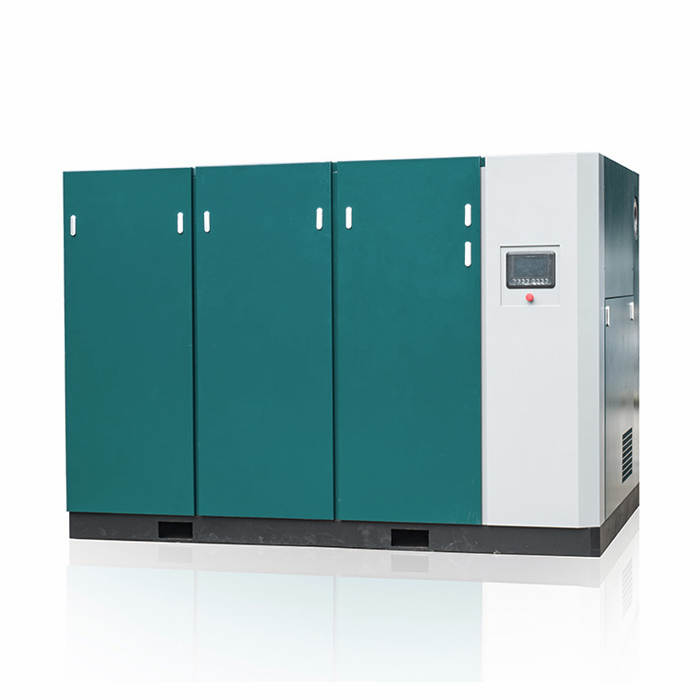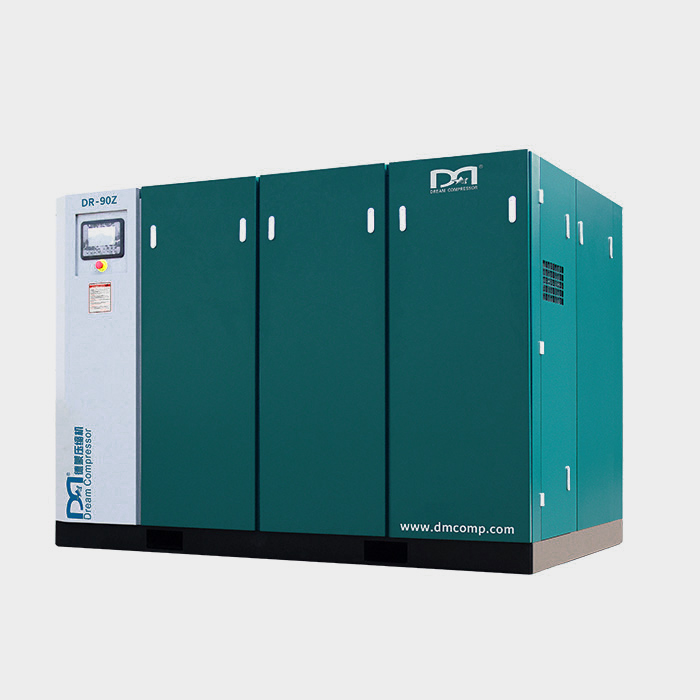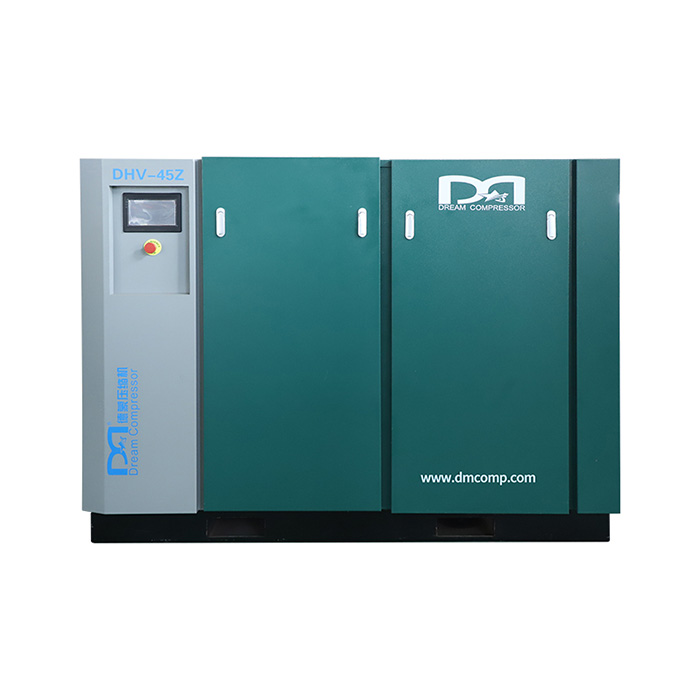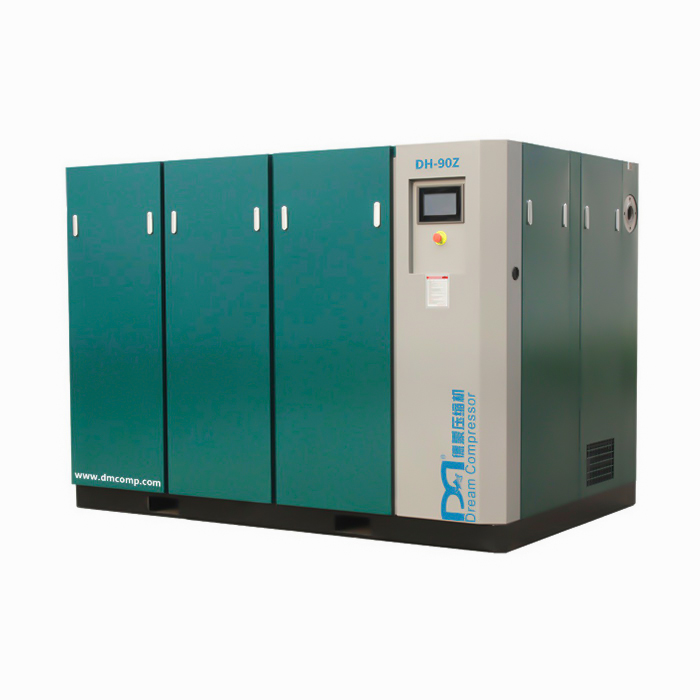In today’s modern manufacturing facilities, key plant personnel are faced with a number of challenges. How do I maximize production? How do I reduce costs? What type of improvements will give me the greatest return? The questions plant managers must continually ask themselves are as common as they are important: “Is my plant operating at peak efficiency and is my ‘cost per widget’ as low as it can possibly be?”
Among the many “systems” plant personnel are concerned with, the compressed air system often provides the biggest opportunity for improvement and overall savings. There are many manufacturers and several air compressor technologies to choose from. Reciprocating or rotary? Fixed speed or variable speed? Oil flooded or oil free? Single-stage or two-stage technology? It’s enough to make anyone want to run and hide!
This article discusses single-stage versus two-stage rotary screw air compressors and the pros and cons of each technology. Both have a place and there are some distinct differences between the two.
Rotary screw air compressors often provide plants with the biggest opportunity for improvement and savings.
Rotary Screw Compression Fundamentals
The principle of rotary screw air compression is really no different than reciprocating (piston) compression. Both are positive displacement machines that take in a fixed volume of air at atmospheric pressure with each revolution and reduce that volume to increase pressure to some value above atmospheric.
Unlike reciprocating air compressors that use a cylinder and piston arrangement in a linear compression process, rotary screw air compressors use a pair of intermeshing screws (rotors) contained in a stator housing (airend), with an inlet port on one end and a discharge port on the other end. The male rotor has “lobes” cut in a helical (spiral) pattern down the length of the rotor, and the female rotor has matching “flutes” (grooves) cut in a helical pattern down its length. The male and female rotors are cut to very tight tolerances and intermesh together as they turn. As the tips of the male and female rotors come together on the inlet port side of the airend, there is a vacant space (volume) where atmospheric air is sucked into the compression chamber.
Once the male and female rotor have “met” at the inlet port, the volume of air taken in becomes trapped between the lobes/flutes and the stator housing. Because of the helical pattern of the lobes/flutes on the rotors, the space between the rotors and the stator housing is gradually reduced until the intermeshing rotors are exposed to the discharge port. At the discharge, the volume of atmospheric air that was taken in has been reduced, resulting in a higher pressure per Boyle’s Law: volume and pressure are inversely related.
Basic Units of Measure
Pressurized air contained in a sealed system is stored energy that can be used for “work” by allowing the air to expand back to atmospheric pressure. It’s the expansion of the compressed air back to atmospheric conditions that conveys air down the pipe, powers linear and rotary actuators, powers automated production equipment, and a plethora of other useful “work.”
There are three basic units of measure to consider when talking about a compressed air system…flow, pressure, and power.
· Flow is a measure of volume rate and is expressed in cfm, which stands for Cubic Feet per Minute. Keep in mind “cfm” is a generic description and without further definition of ambient conditions and the point at which the measurement is taken, it is really a meaningless number. One should educate themselves about the differences between acfm, scfm, and icfm. For purposes of this discussion, we will use the generic description, cfm.
· Pressure is a measure of force and is expressed in psi, which stands for Pounds per Square Inch. It is a generic description as well, and without further clarification as to what kind of pressure you’re talking about, psi is really a meaningless number. One should educate themselves about the differences between psia, PSIatm, and psig. For purposes of this discussion, we will use the generic description, psi.
· Power is a measure of the energy required to produce x rate of flow, at y pressure and is expressed in kW, which stands for kilowatts.
Technically, end users do not pay for compressed air, they pay for the energy (kW) required to produce the desired flow and pressure. The challenge for the end user is to determine the most efficient way to produce the required volume of compressed air at the required pressure.
Single-stage Versus Two-stage Compression
There are two basic types of rotary screw compression: single stage and two stage.
A single-stage rotary screw air compressor contains a single set of rotors in a single stator housing and is typically driven directly by the motor shaft, through a set of gears, or by a belt and pulley arrangement. A two-stage rotary screw air compressor contains two sets of synchronized rotors and can be housed in a common stator housing (over/under design) or two separate stator housings bolted together in tandem (end-to-end design).
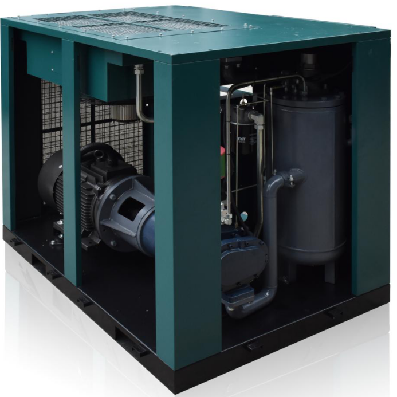
A two-stage over/under airend design features first-stage compression on the top, interstage cooling between the compression chambers, and second-stage compression at the bottom.
The over/under design utilizes “interstage” cooling via an injected “curtain” of lubricant/coolant, which improves overall efficiency. Two-stage rotary screw air compressors are typically direct or gear drive. A single-stage rotary screw air compressor takes in atmospheric air and does “the work” (x rate of flow, at y pressure) in one compression process. A two-stage rotary screw compressor takes in atmospheric air but “shares the work” over two separate compression processes and cools it in between.
The difference between the two is not the end result, rather the energy required to produce the end result. A simple analogy: If you were asked you to push your car from point A to point B on a level parking lot, it would require a certain amount of energy on your part to do so. If you had a friend help push the car the same distance, the end result would be the same, but it would require less energy overall because the work is being done by two people instead of one!
It’s important to note every application is unique, and all rotary screw air compressors of a given size and technology have similar but different performance characteristics (flow, pressure, power consumption). The intent of this discussion is to demonstrate the differences between single-stage and two-stage compression and is not based on actual applications. There are pros and cons to everything, and air compressors are no different. Both single-stage and two-stage rotary screw air compressors have their place in industry and plant managers are charged with making the right choice based on their unique needs and requirements. End users should make sure they’re working with a compressed air professional who has the credentials to design the correct system.
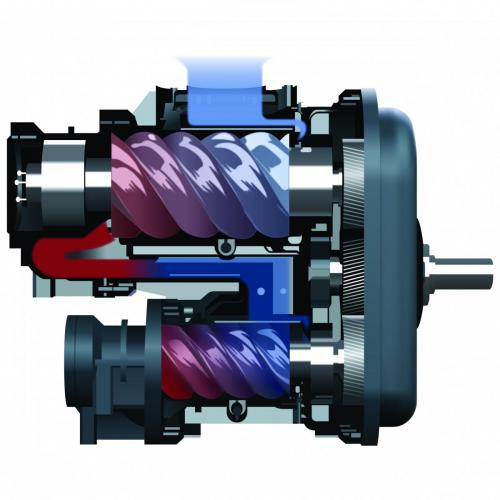
Single-Stage Air Compressor Pros and Cons
Single-stage rotary screw air compressors are lower in initial cost than two-stage air compressors, so if you’re working with a limited budget, there are plenty of reliable and efficient solutions, readily available from a wide variety of manufacturers.
Single-stage rotary screw air compressors are manufactured in a wide range of horsepower sizes, generally from three to 600 horsepower (hp), which makes them a versatile solution for multiple air compressor applications with different “demand profiles” between shifts or even during the same shift. Single-stage air compressors offer multiple options such as tank mount, integral dryer, open or enclosed, and a choice of micro-processors (controller). As with two-stage, multiple control methods are available on single-stage air compressors.
All single-stage air compressors use pressure at the discharge of the air compressor to control the operation of the machine. Load/unload controls allow the air compressor to operate at its two most efficient points on the “power curve,” meaning full load (compressing air) and unload (running but not compressing air). It’s important to note that the “most efficient” air compressor is the one that is turned off! With proper receiver storage capacity, load/unload controls can approach efficiency levels close to that of variable speed. Without proper air receiver storage, load/unload can put undue stress on the airend bearings and shorten its life expectancy.
Modulation control “throttles” the inlet valve via an air pressure signal from the discharge and allows the air compressor to stay in a loaded condition when plant demand is variable and load/unload controls may cause the air compressor to “rapid cycle” (loading and unloading in short rapid cycles). While modulation may extend the life of the airend by reducing or eliminating the on/off thrust loads associated with load/unload, it is very inefficient. Variable Speed Drive (VSD) technology senses the discharge pressure and varies the speed of the main motor, delivering the best part-load efficiencies of all the control methods. Single-stage rotary screw air compressors offer several different drive arrangements to choose from including belt drive, direct drive and gear drive, giving you the flexibility to select the right drive arrangement for your particular application and maintenance capabilities.
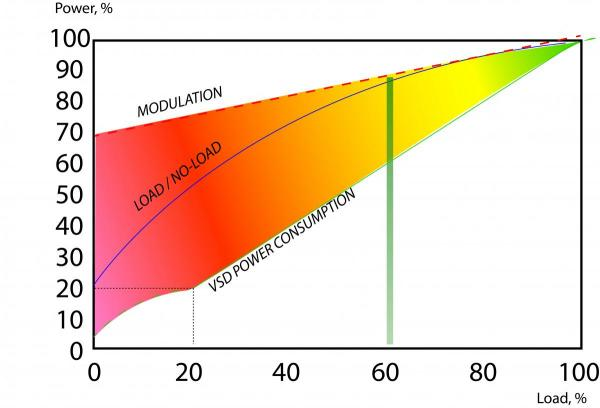
Shown are efficiency differences of single-stage and two-stage air compressors using load/unload, modulation, and Variable Speed Drive methods of control at any particular point on the power curve.
Although the life expectancy of any rotary screw airend is dependent on the installation conditions, the level of maintenance performed, and the application itself, single-stage airend life expectancy is generally less than that of a two-stage rotary screw airend...more on that later. Whatever brand you buy, make sure the manufacturer is a member of the Compressed Air & Gas Institute (CAGI) Third Party Performance Verification program. CAGI uses third-party verification to substantiate the claims manufacturers make about performance (flow rate at pressure, and energy consumption). Energy efficiency in single-stage rotary air compressors has improved over the years and with CAGI’s Third Party Verification Program, you can be confident the performance characteristics claimed by participating manufacturers are accurate. It’s important to note that not all manufacturers participate in the CAGI Third Party Performance Verification Program.
Two-Stage Air Compressor Pros and Cons
By now, it should be clear the biggest advantage of two-stage compression over single-stage compression, is energy efficiency.
Two-stage technology is more limited in terms of horsepower range (typically 125 hp plus) as is the number of manufacturers that produce this technology. As you might have guessed, the initial purchase price of two-stage technology is higher.
Two-stage air compressors are available with the same control schemes as single-stage machines, but there are fewer options at your disposal as one might imagine…you can’t physically mount a 125 hp plus air compressor on a tank! Depending on which type of two-stage air compressor you consider (over/under versus tandem design), the footprint might be larger than a single-stage machine offering…there’s just more stuff inside the box!
The energy efficiency advantages of two-stage compression over single-stage compression are maximized in high, relatively steady-flow applications, when the two-stage can be applied as a “base load” air compressor. In other words, “let the big dog eat.” Two-stage energy efficiency benefits are best realized when the air compressor runs at 100% full load, all the time. The initial cost of a two-stage rotary screw air compressor can be as much as 30% higher when compared to the equivalent size single-stage air compressor, a distinct disadvantage if you’re working with a limited budget.
On the surface this looks drastic but because the two-stage air compressor is more efficient, you’ll likely be able to supply the required flow with less hp and this will help close the gap to about 15 to 20 percent. But still, why would anyone pay more for a smaller air compressor? The answer is simple…because the initial purchase price of the air compressor is but a fraction of the total cost of ownership. You pay for the air compressor once, but you pay for the power to run that air compressor for its entire lifespan.
Factor Power Costs into Purchasing Decision
Power costs represent up to 75% of the total cost of ownership of a rotary screw air compressor, and the energy savings over the life of a two-stage air compressor can be significant.
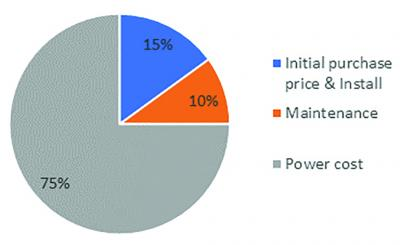
Rotary screw air compressor “lifecycle” ownership costs.
For example, let’s assume your plant operates twenty four hours a day, seven days a week (8,736 hours per year), requires 1,000 cfm at 125 psi to meet production requirements, and you pay $.10/kWh to your local power company.
Option A offers the following:
· 250 hp single-stage rotary screw air compressor.
· Rated for 1,029 cfm at full load and 125 psi.
· Consumes 212.6 kW at full load (1,029 cfm).
· Motor efficiency of 96%.
· $65,000 sell price.
Option B offers the following:
· 200 hp two-stage rotary screw air compressor.
· Rated for 1,074 cfm at full load and 125 psi.
· Consumes 188 kW at full load (1,074 cfm).
· Motor efficiency of 96%.
· $78,000 sell price.
Option A’s single-stage offering may be a very efficient and cost-effective solution when compared to other single-stage offerings, but the mechanical advantages of two-stage compression (“sharing the work”) makes it worthy of serious consideration. This simple formula [(kW X hours)* rate]/motor efficiency gives a good estimate of what the annual power cost of each would be:
· Power cost of Option A - 250 hp single stage: 212.6 X 8,736 X .10/.96 = $193,466 per year.
· Power cost of Option B - 200 hp two-stage: 188 X 8,736 X.10/.96 = $171,080 per year.
Both air compressors supply the required cfm at the required pressure, but the two-stage unit does it more efficiently, saving $22,386 per year in power costs. Option B is 20% ($13,000) more than the single -stage air compressor, but the power savings alone will recover the two-stage premium price in seven months ($13,000/$22,386). In fact, with the energy savings the two-stage air compressor will pay for itself in its entirety in about 3.5 years when compared to what would have been spent with the single-stage offering ($78,000/$22,386). From that point on, the $22,386 savings happens every year and goes right to your bottom line! An added benefit of two-stage technology over single-stage is longer air end life.
Why Longer Life Expectancy with Two-Stage Compression?
Couple the power savings benefits of two-stage technology in the example with longer airend life expectancy than single-stage technology, and the savings become quite significant over time! As with single-stage rotary screw air compressors, the buyer should ensure that all manufacturers being considered are members of the CAGI Third Party Performance Verification Program to ensure the performance data being quoted is accurate.
So why is the life expectancy of a two-stage machine greater than a single-stage air compressor? It has to do with compression ratio and thrust (axial) Load. Compression ratio is the ratio between the absolute discharge pressure and the absolute inlet pressure (absolute pressure considers atmospheric pressure and gauge pressure) and is expressed by the formula: gauge pressure + atmospheric pressure/ atmospheric pressure. As compression occurs down the length of the airend and pushes against the surface area of the rotors, a thrust load directly proportional to the compression ratio created.
For example: to reach 100 psig at sea level (atmospheric pressure = 14.7 psia) with a single-stage rotary screw air compressor, the compression ratio is (100 plus 14.7)/14.7 = 7.8. In other words, you would have to compress one cubic foot of atmospheric air at sea level, by 7.8 times to raise the pressure to 100 psig. The higher the required final pressure, the higher the compression ratio. The higher the compression ratio, the more thrust load is put on the airend bearings.
All rotary screw air compressors have thrust bearings to handle this axial load, but because the single-stage air compressor is compressing air from atmospheric pressure to final discharge pressure over a single compression process, the thrust loads are greater than the two-stage unit that shares the work and utilizes interstage cooling to remove heat of compression from the first stage. Compression ratios in two-stage rotary air compressors can be as low as 3.1 in the first stage, and 2.5 in the second stage. A lower compression ratio equates to lower thrust load on the bearings, yielding a more robust, reliable, and longer lasting air compressor. Back to our car analogy… While you’re struggling to push your car from point A to point B, you’re putting a load on your “bearings” …your back, your legs, your arms, your shoulders, etc. If a friend helps, you put less load on your “bearings” and you last much longer than the person pushing by themselves!
One Size Does Not Fit All
At the end of the day, single-stage and two-stage rotary screw air compressor technologies are both robust and reliable solutions for a very large sector of industry. There are distinct differences between the two, and one size does not fit all.
Both technologies are firmly rooted in industry and each has its place. There are a host of variables the purchaser of a rotary screw air compressor should consider. In this article we’ve covered the technology (single-stage versus two-stage technologies), initial purchase price, power costs, and airend life expectancy. There are many other variables to consider such as incoming power requirements, noise level, ease of maintenance, air compressor room layout and environment, and ancillary equipment. This is not an exhaustive list and the buyer should do their due diligence to ensure that the compressed air professional they’re working with understands how all of these variables play into the most economical, efficient, and reliable compressed air solution.









